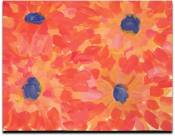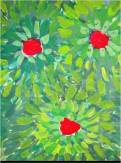My fourth graders study brush strokes as a part of the curriculum. It used to be a difficult concept for me to teach, but this lesson has helped create painters out of my students. Art teachers often teach painting with color theory, but few teach the application of paint to a surface. Without learning a painterly technique, students tend to draw with paint, using lollipop shapes and colors with black outline edges.
The process to create the paintings is simple: use a primary color as a center “dot” (for example red). Create a painting around that spot, using the complementary color. Mix various colors, including black and white, with that complement. Last, students paint with a short brushstroke, no longer than a thumb. Our technique: press the brush with paint to the paper and lift it. This is important because students were used to drawing (and painting) lines. Students were encouraged to bring wider, bigger brushes from home; some smart, lazy students loved this!
To help students remember the sets of complementary colors, we call them Christmas colors – red and green, Bronco colors – blue and orange (this IS Colorado!) and Easter colors – purple and yellow.
We discussed that each person’s brushstroke is like a unique fingerprint and looked at many artist’s paintings, such as Van Gogh’s and Monet’s. Students learned color theory, painting skills, and insight into the brushstroke techniques of the Impressionists. It was a painterly experience!




